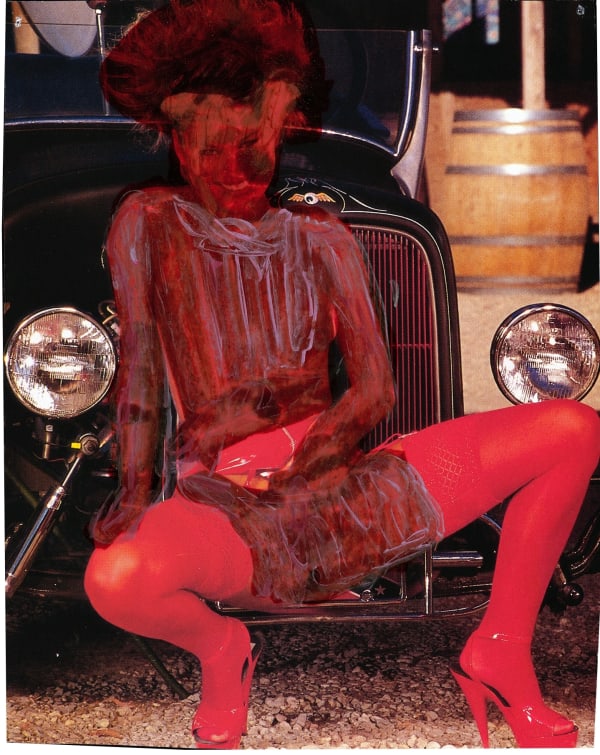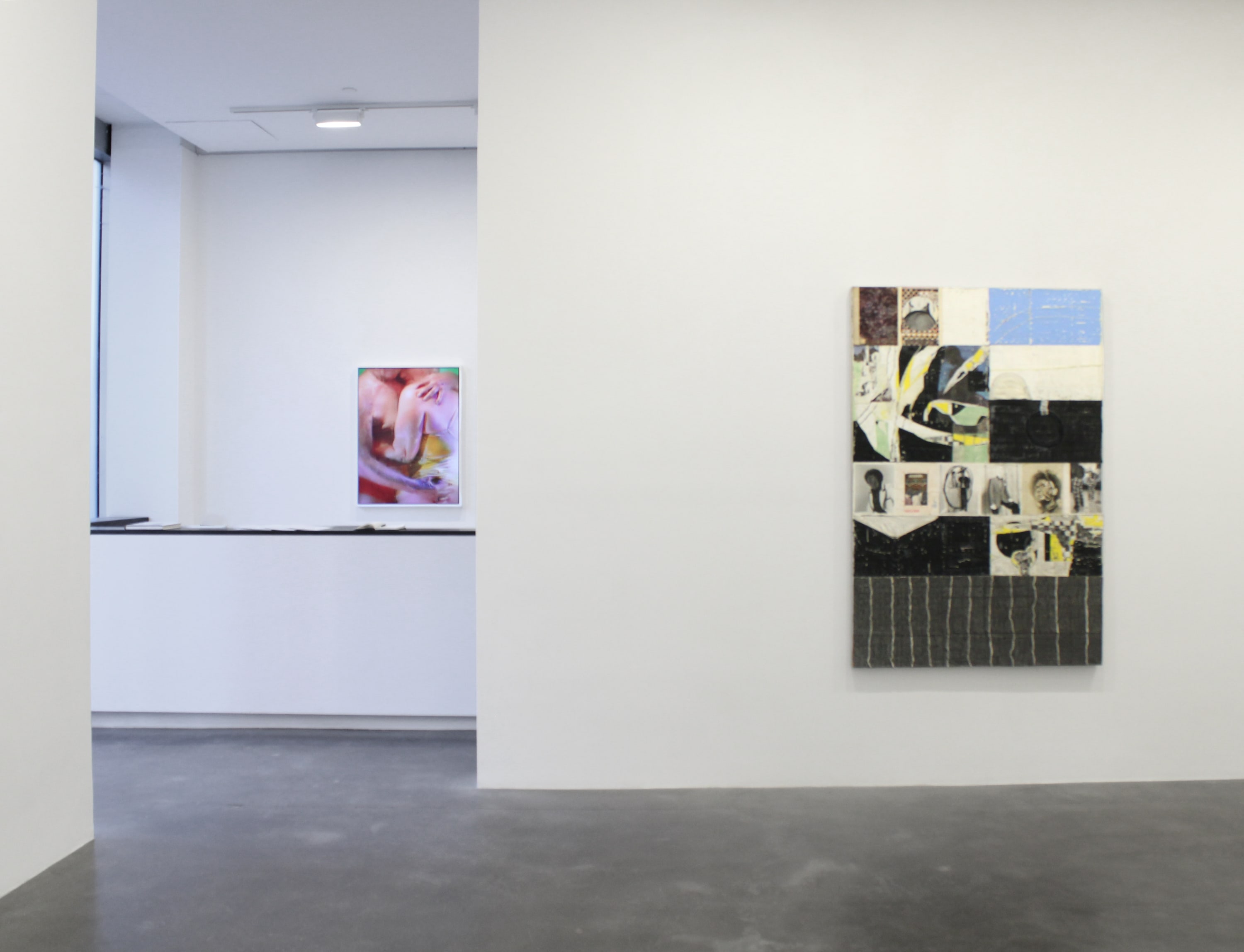-
THE BOYS CLUB
Nina Hartmann, Troy Montes Michie, Marilyn Minter, Natalie Ochoa, Erica Rutherford, Beverly Semmes, and Susan Weil -
Nearly seventy years ago, Whitechapel Gallery staged This is Tomorrow, a seminal exhibition featuring practitioners of Lawrence Alloway’s "fine art/popular culture continuum," better known as the Independent Group. Grappling with post-war industrialism, this continuum reflected a new standardization of culture, one that was disseminated through mass media and realized through commerce.
When soldiers returned home and the baby boom commenced, a culture of consumption was ignited. Driven by post-war optimism, traditionally upper-class products and appliances were marketed as essential commodities. The right home, car, and dishwasher could make identity and personal satisfaction easy to secure. Such commodification of the consumer, as noted by William Leach, established a new measure of individual value:
-
“The cardinal features of this culture were acquisition and consumption as the means of achieving happiness; the cult of the new; the democratization of desire; and money value as the predominant measure of all value in society.”¹
-
 Installation view, " THE BOYS CLUB (Redacted)," Curated by Cortney Connolly, at Susan Inglett Gallery, NYC, 5 December 2024 - 25 January 2025
Installation view, " THE BOYS CLUB (Redacted)," Curated by Cortney Connolly, at Susan Inglett Gallery, NYC, 5 December 2024 - 25 January 2025 -
Shifting towards accessibility and direct engagement, culture transitioned from the life of the mind as practiced in the salons of the elite and privileged to a mass-produced array of films, print media (specifically comics), radio, and music. These mediums, bolstered by the rise of in-home radios and televisions, became industries— creating a clear contrast to the consumer model of high art. In response, Alloway argued that art should depart from pre-war elitist ideals of high thought and art, promoting a more accessible and directly engaged commentary on culture.
-
“... Mass production techniques, applied to accurately repeatable words, pictures, and music, have resulted in an expendable multitude of signs and symbols. To approach this exploding field with Renaissance based ideas of the uniqueness of art is crippling. Acceptance of mass media entails a shift in our notion of what culture is. Instead of reserving the word for the highest artifacts and the noblest of thoughts of history’s top ten, it needs to be used more widely as the description of what society does.” ²
-
 BEVERLY SEMMES, Green Shoe, 2024
BEVERLY SEMMES, Green Shoe, 2024 -
As we sink deeper into the Information Age, the noise of headlines, bold print, and imagery has led to an exhaustion of mass media. Generation Z has become a catalyst for a mass withdrawal from the mainstream, co-opting strategies from fiercely gatekept subcultures and niche networks. Nostalgia-obsessed, Generation Z increasingly appropriates punk, indie-sleaze, and Y2K aesthetics (among others), resulting in a surface-level performance of identity. In an attempt to withdraw from consumerist goods and validation, Generation Z’s shift toward socialization and identity has created a new playground for mass marketing.
Social media is used by nearly 70% of the population. Platforms like TikTok and Instagram collect user interactions to organize a personalized experience and successfully deploy niche marketing. In this era of data mining, Generation Z interests have dictated the direction of mass media’s expansion.
-
 TROY MONTES MICHIE, Phases (Detail), 2020
TROY MONTES MICHIE, Phases (Detail), 2020 -
The allure of being an “individual” has become a consumable product, organizing and progressing the consumerist positive feedback loop. To disrupt this cycle, one must first recognize how body and individual expression are sold back to its performer.
As an act of intervention and reclamation, THE BOYS CLUB brings together artists of various generations and disciplines who use the methodologies of Pop Art to interrogate the power systems bolstered by mass communication. Featuring demographics not originally included in the Independent Group (queer and femme), the exhibition presents work by Nina Hartmann, Troy Montes Michie, Marilyn Minter, Natalie Ochoa, Erica Rutherford, Beverly Semmes, and Susan Weil.
- Cortney Connolly
-
 NINA HARTMANN, Mind Control Image Connectivity (Maze B), 2024
NINA HARTMANN, Mind Control Image Connectivity (Maze B), 2024 -
The image (on the right) comes from a somewhat famous demonstration that Delgado held in Spain using his own stimoceiver invention. From wiki: “The most famous example of the stimoceiver in action occurred at a Córdoba bull breeding ranch. Rodríguez Delgado stepped into the ring with a bull which had had a stimoceiver implanted within its brain. The bull charged Delgado, who pressed a remote control button which caused the bull to stop its charge. Always one for theatrics, he taped this stunt and it can be seen today.”
The other images are tied to this line of research, questioning, and networking: showing an image of a supposed Soviet mind control device from a WIRED article (now removed) without much supplemental information, and an image of government surveillance project ECHELON in the middle, which also has conspiratorial ties to government Mind Control.
- Nina Hartmann
-
 TROY MONTES MICHIE, Phases, 2020
TROY MONTES MICHIE, Phases, 2020TROY MONTES MICHIE
Troy Montes Michie, using collage as a methodology, explores print media’s influence on mass culture and intervenes in modes of consumption. In Phases (2020), images from vintage pornography are overlaid with drawn clothing, paint, a wire hanger, and cut textile and paper, assembling queer-coded symbolism to subvert mass media narratives. Through juxtaposition and assemblage, Michie interrogates how the Black male body has been criminalized, fetishized, and marginalized.
“Michie’s [work] suggests a commonality between tailoring and collaging, attributing to both practices a quality of artistic invention and aesthetic splendor—either on our bodies or on canvas.”
-Christian LiclairThe Brooklyn Rail -
 MARILYN MINTER, Nuzzle, 2022
MARILYN MINTER, Nuzzle, 2022 -
“Pop appealed widely because, on the surface, it mimicked public language. The public had little idea of the investigative codes of these artists, many antagonistic to illustration and commercial art."
- Sid Sachs
"Beyond the Surface: Women and Pop Art 1958- 1968"
Seductive Subversion: Women Pop Artists 1958- 1968
p. 30
-
 NATALIE OCHOA, Untitled 1, 2023
NATALIE OCHOA, Untitled 1, 2023 -
 ERICA RUTHERFORD, The Startled Model, 1977
ERICA RUTHERFORD, The Startled Model, 1977 -
 BEVERLY SEMMES, Eye on Blue, 2024
BEVERLY SEMMES, Eye on Blue, 2024 -
 SUSAN WEIL, Color 11, 1999
SUSAN WEIL, Color 11, 1999SUSAN WEIL
Susan Weil, a Black Mountain College alumnus and contemporary of famed American pop artists, was linked by time and proximity to that male-dominated movement where the female body was interchangeable with a bottle of Coca-Cola. Assembling a grid of fractured limbs, as seen in Color 11, 1999, Weil reclaims that body, its disjointed surface potentially reflecting the marginalization she experienced as a wife, mother, and artist at the time.
“In her Configurations series of collages, the nude female figure is loosely painted on a series of small pieces of paper, collaged together to form a grid. Taken as a whole, these paintings articulate a dynamic sense of fractured movement reminiscent of the 19th century photographer Eadweard Muybridge, who is a touchpoint in her practice.”
- JDJ
-
![“…[Women] were considered the primary agents of consumerism; ads for hard goods, innovative products, new cleansers, clothes, and cosmetics as...](data:image/gif;base64,R0lGODlhAQABAIAAAAAAAP///yH5BAEAAAAALAAAAAABAAEAAAIBRAA7) SUSAN WEIL, Untitled, 1998
SUSAN WEIL, Untitled, 1998 -
Installation view, " THE BOYS CLUB (Redacted)," Curated by Cortney Connolly, at Susan Inglett Gallery, NYC, 5 December 2024 - 25 January 2025
-
¹ Leach, William R. Land of Desire: Merchants, Power, and the Rise of a New American Culture. New York: Pantheon Books , 19932² Alloway, Lawrence. “The Long Front o f Culture,” 1959, p 1.3 Expert Panel.
³ “Council Post: How to Appeal to Gen-Z without Obviously 'Marketing to Gen-Z.'” Forbes , 12 Aug. 2024,
www.forbes.com/councils/forbescoachescouncil/2022/08/24/how-to-appeal-to-gen-z-without-obviously-marketing-to-gen-z/.
THE BOYS CLUB (Redacted): Curated by Cortney Connolly
Current viewing_room












![“…[Women] were considered the primary agents of consumerism; ads for hard goods, innovative products, new cleansers, clothes, and cosmetics as...](https://artlogic-res.cloudinary.com/w_620,h_620,c_limit,f_auto,fl_lossy,q_auto/ws-artlogicwebsite0034/usr/images/feature_panels/image/items/5e/5e3b36710b1f49bd98719a3e755f05cd/susan-weil_color-11-1999_acrylic-on-paper_60.5-x-66.5-in_corner_jdj-copy.jpg)
